Kopnin N.B. Theory of Nonequilibrium Superconductivity
Подождите немного. Документ загружается.


Integrating the first term in the r.h.s. by parts we find that it is equal to
end p.266
The surface term vanishes because f
1
= 0 at = r
0
for | | > | |
max
, and
at = for | | < | |
max
. The energy integral is
determined by
~ | | and the spatial integral converges at distances of the
order of
(T). The equation of the force balance becomes
where we denote
We put here
As a result,
(13.24)
and, as usually,
PRINTED FROM OXFORD SCHOLARSHIP ONLINE (www.oxfordscholarship.com)
© Copyright Oxford University Press, 2003-2010. All Rights Reserved
Oxford Scholarship Online: Theory of Nonequilibrium Supe... http://www.oxfordscholarship.com/oso/private/content/phy...
第2页 共6页 2010-8-8 16:06
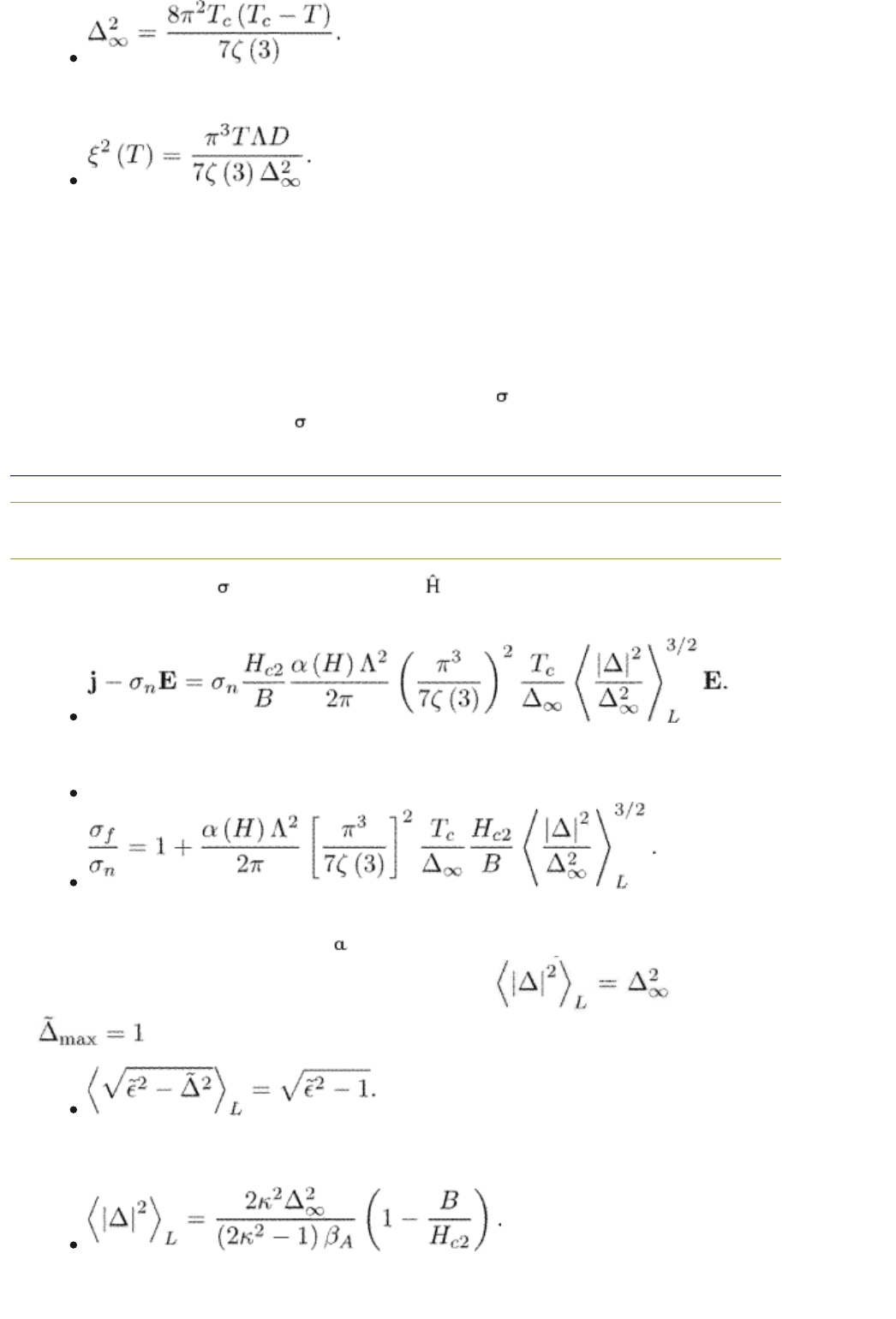
The coherence length is defined by eqn (6.26)
For high magnetic fields when vortices are closely packed, it is not easy to solve
eqn (13.18) because the vortex lattice does not have an axial symmetry any
more. To simplify calculations, we adopt the approximation of the round unit cell
even for high vortex density. Within this approximation, we obtain the same
solution as before even for high magnetic fields. Therefore, we shall use eqn
(13.24) as an approximation for the whole range of magnetic fields.
For well separated vortices at low fields one can neglect the normal current in
the l.h.s. of eqn (13.24). Indeed, it is of the order of
n
E while the term in the
r.h.s. has an order of (H
c2
/B)
n
E. For fields close to the upper critical field
end p.267
H
c2
, one has j(
nst
) =
n
E. Putting v
L
= c[E × ]/B one thus can write an
interpolation expression
The flux flow conductivity becomes
(13.25)
This result was obtained by Gor’kov and Kopnin (1973 a) and by Larkin and
Ovchinnikov (1986). The function
(H) is of the order of unity. To calculate it for
well separated vortices at low fields we observe that
and
; moreover
On the other hand, for high fields
The high-field flux flow conductivity becomes
PRINTED FROM OXFORD SCHOLARSHIP ONLINE (www.oxfordscholarship.com)
© Copyright Oxford University Press, 2003-2010. All Rights Reserved
Oxford Scholarship Online: Theory of Nonequilibrium Supe... http://www.oxfordscholarship.com/oso/private/content/phy...
第3页 共6页 2010-8-8 16:06
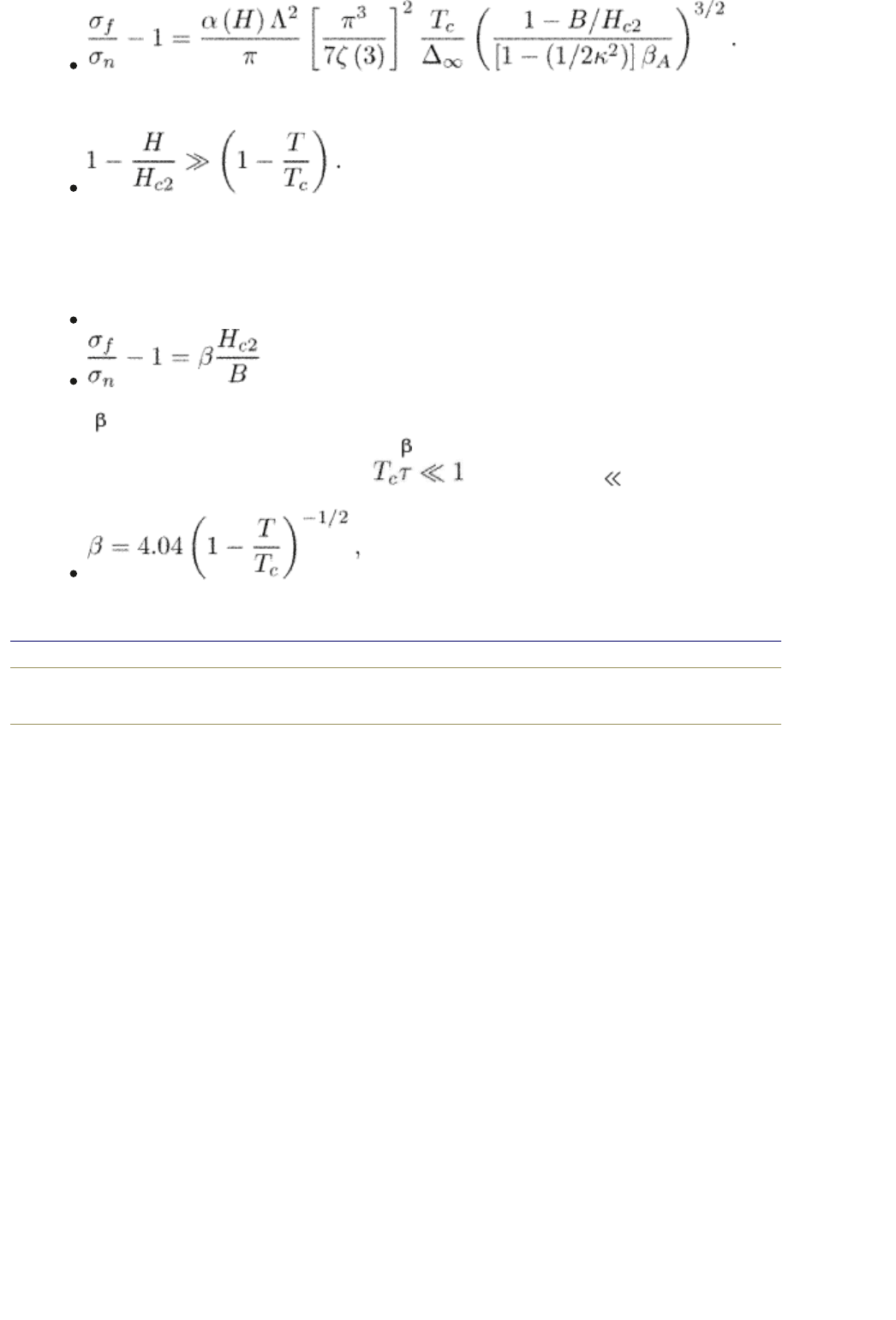
As a function of the magnetic field, this expression is valid until
For higher fields, the superconductor becomes essentially gapless, and the
regular TDGL contribution [the first term in the r.h.s. of eqn (13.15)] dominates.
Equation (13.25) can be written in a form similar to eqn (12.54)
(13.26)
where is a function of temperature, magnetic field, and, also of the electron
mean free path. The numerical values for
are listed in the review by Larkin and
Ovchinnikov (1986). In the dirty limit
. one has for H H
c2
end p.268
PRINTED FROM OXFORD SCHOLARSHIP ONLINE (www.oxfordscholarship.com)
© Copyright Oxford University Press, 2003-2010. All Rights Reserved
Oxford Scholarship Online: Theory of Nonequilibrium Supe... http://www.oxfordscholarship.com/oso/private/content/phy...
第4页 共6页 2010-8-8 16:06
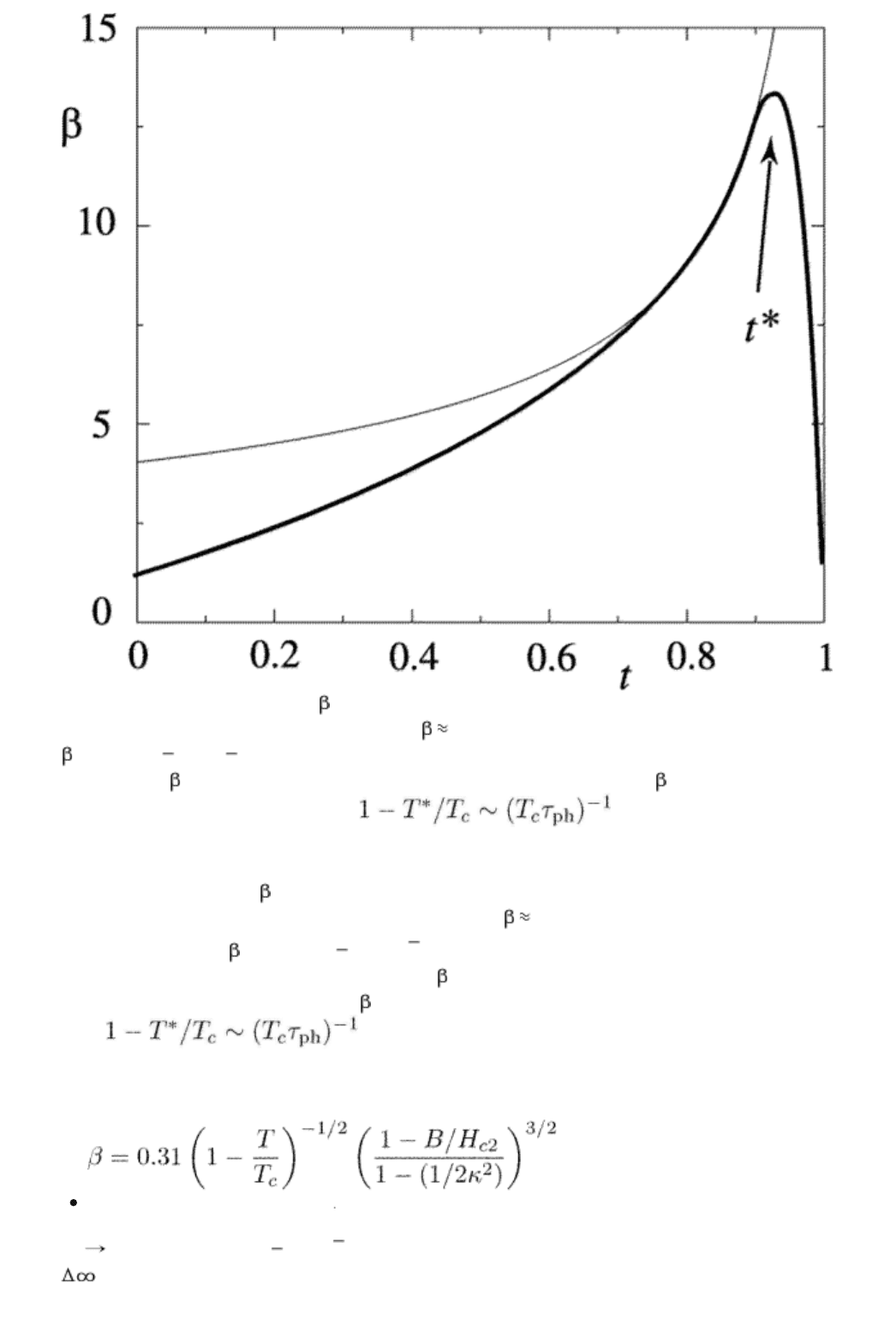
." title="Fig. 13.1. The factor as a function of temperature, t = T/Tc. The
solid line is an interpolation between: (i)
0.9 at zero temperature, (ii)
= 4.04(1 T/Tc) 1/2 in the region close to Tc (thin line), and (iii) the
TDGL result
= 1.45 for T = Tc. The temperature t* = T*/Tc where
reaches its maximum is such that ."
class="figure">
F
IG. 13.1. The factor as a function of temperature, t = T/T
c
.
The solid line is an interpolation between: (i)
0.9 at zero
temperature, (ii)
= 4.04(1 T/T
c
)
1/2
in the region close to
T
c
(thin line), and (iii) the TDGL result = 1.45 for T = T
c
. The
temperature t* = T*/T
c
where reaches its maximum is such
that
.
and
for H H
c2
. The factor (1 T/T
c
)
1/2
follows form eqn (13.25) due to the term
T
c
/ in the right-hand side.
Oxford Scholarship Online: Theory of Nonequilibrium Supe... http://www.oxfordscholarship.com/oso/private/content/phy...
第5页 共6页 2010-8-8 16:06
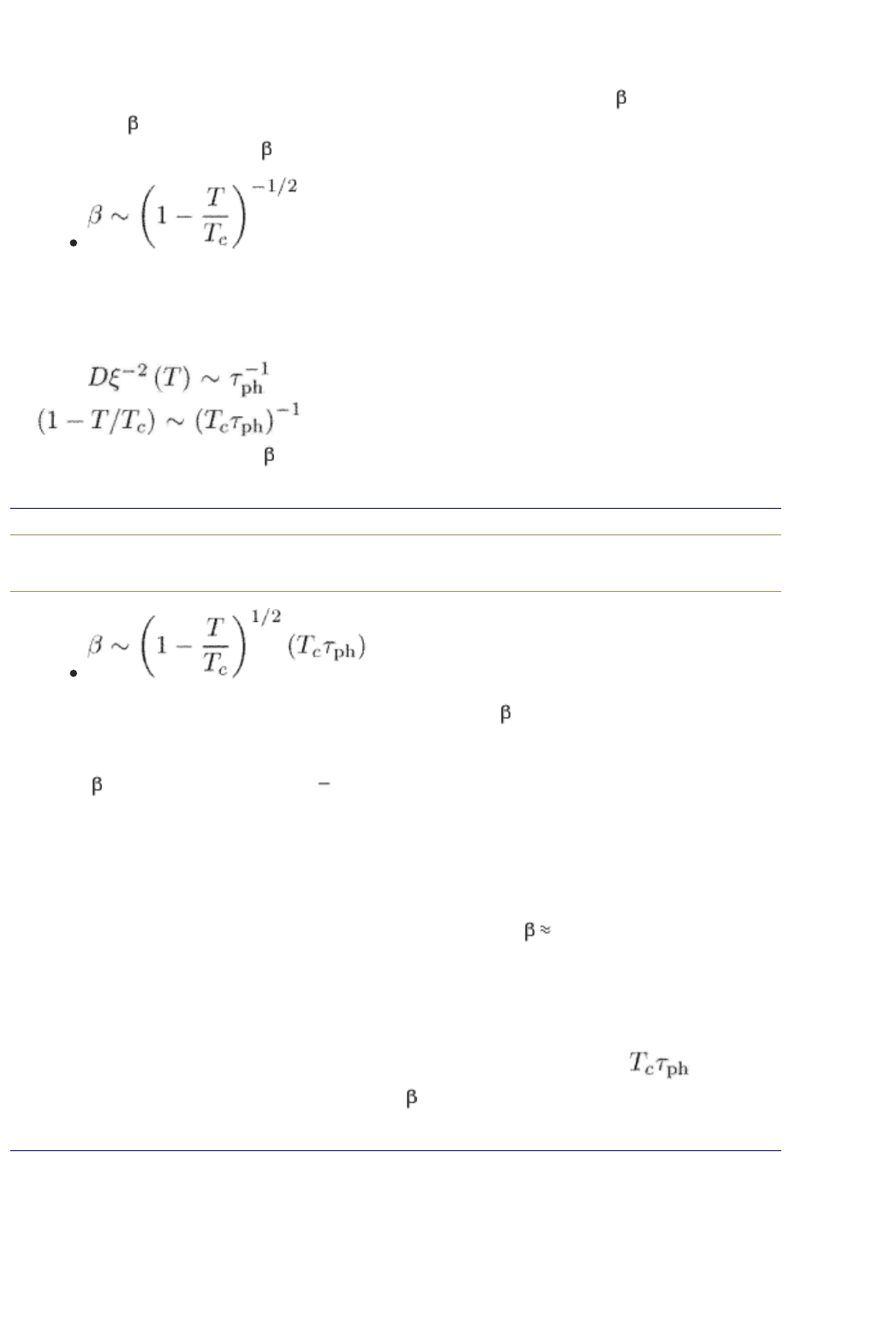
13.2.1 Discussion
We note first of all that the flux flow conductivity in dirty superconductors
appears to be much larger than what is predicted by the simple TDGL model or by
the Bardeen–Stephen model. Indeed, for low inductions the factor
in eqn
(13.26) is
= 1 within the Bardeen–Stephen model. The microscopic theory,
however, predicts a large
near T
c
which grows as
when T approaches T
c
. This is the consequence of a decrease in the diffusion
relaxation rate when the size of the vortex core increases near T
c
with an
increasing coherence length. When temperature is close enough to T
c
the
diffusion relaxation rate becomes comparable with the inelastic relaxation rate
when
. This happens for temperature
at the border of applicability of eqn (13.25). At
this point, the increase in
saturates at
end p.269
which has the same order of magnitude as the factor ~ F(q) in eqn (12.54).
This is exactly the regime which is described by the generalized TDGL scheme
discussed in Section 12.8. When the temperature approaches T
c
. even closer, the
factor
starts to decrease as (1 T/T
c
)
1/2
down to values of the order of unity
according to eqn (12.54).
We have only discussed a vicinity of the critical temperature. The
low-temperature behavior of the How conductivity in dirty superconductors can
also be considered within the same framework based on the kinetic equations
derived in Section 10.5. This was done by Gor’kov and Kopnin (1973 b). The
result approaches the Bardeen and Stephen model with
0.9. The overall
behavior of the flux flow conductivity in a dirty superconductor as a function of
temperature is shown schematically in Fig. 13.1. Experimental data for
conventional duty superconductors generally lie above the results of ihe
Bardeen–Stephen model; on the other hand, they are below the predictions of
the exact microscopic theory (see the reviews by Gor’kov and Kopnin 1975 and
by Larkin and Ovchinnikov 1986). The reason is that the parameter
is not
that large in practice, thus the increase in
is limited to lower values.
end p.270
Top
Privacy Policy and Legal Notice © Oxford University Press, 2003-2010. All rights reserved.
PRINTED FROM OXFORD SCHOLARSHIP ONLINE (www.oxfordscholarship.com)
© Copyright Oxford University Press, 2003-2010. All Rights Reserved
Oxford Scholarship Online: Theory of Nonequilibrium Supe... http://www.oxfordscholarship.com/oso/private/content/phy...
第6页 共6页 2010-8-8 16:06

14 VORTEX DYNAMICS IN CLEAN SUPERCONDUCTORS
Nikolai B. Kopnin
Abstract: The general features of the vortex dynamics in clean superconductors
are first discussed using the Boltzmann kinetic equation. The conditions when the
dissipative dynamics of vortices transforms into a Hamiltonian one are
established. The crucial importance of excitations localized in vortex cores is
clarified. Next the quasiclassical Green function technique and the kinetic
equations of the previous chapters are used to calculate the longitudinal and Hall
components of the flux flow conductivity for s-wave superconductors. The forces
on a vortex, vortex cross sections, and the flux-flow conductivity are discussed in
detail as functions of temperature and of purity of the superconductor. The
transition from viscous to non-dissipative vortex dynamics is demonstrated to
occur as a function of the relaxation time in superconductor.
Keywords: clean superconductor, vortex dynamics, kinetic equation,
vortex core, flux-flow conductivity, Hall effect, force on vortex, cross
section
We discuss first the general features of the vortex dynamics in clean
superconductors using the Boltzmann kinetic equation. We establish the
conditions when the dissipative dynamics of vortices transforms into a
Hamiltonian one. We emphasize the crucial importance of excitations
localized in vortex cores. Next we use the quasiclassical Green function
technique and the kinetic equations of the previous chapters to calculate
the longitudinal and Hall components of the flux flow conductivity for
s-wave superconductors. We discuss the forces on a vortex as functions of
temperature and of purity of the superconductor.
14.1 Introduction
This chapter is devoted to the vortex dynamics in clean superconductors. Clean
systems offer more intriguing physics than dirty superconductors considered in
the previous section. For example, one of the fundamental problems can be
formulated as follows: Speaking of clean superconductors one can, in particular,
think of such a system where no relaxation processes are available, i.e., the
mean free path of excitations is infinite. In this case, vortices should move
without dissipation since there is no mechanism to absorb the energy. The vortex
velocity should then be parallel to the transport current, which makes the electric
field perpendicular to the current; the dissipation thus vanishes j · E = 0. This
contrasts with what we know from the previous chapters on dirty
superconductors: the vortex motion is dissipative, and each moving vortex
experiences a large friction; it generates an electric field parallel to the transport
current which produces energy dissipation. Clearly, a crossover should occur from
dissipative to nondissipative vortex motion as the quasiparticle mean free path
increases. The question is what is the condition which controls the crossover?
This question is of a fundamental importance for our understanding of the
dynamics of superconductors and, in a more broad sense, for the understanding
of dynamic properties of quantum condensed matter in general. To illustrate the
Kopnin, Nikolai, Senior Scientist, Low Temperature Laboratory, Helsinki University of
Technology, and L.D. Landau Institute for Theoretical Physics, Moscow
Theory of Nonequilibrium Superconductivity
Print ISBN 9780198507888, 2001
pp. [271]-[275]
Oxford Scholarship Online: Theory of Nonequilibrium Supe... http://www.oxfordscholarship.com/oso/private/content/phy...
第1页 共6页 2010-8-8 16:06

problem one can consider a simple example as follows. One can argue that a
time-dependent nondissipative superconducting state, similarly to any other
quantum state, can be described by a Hamiltonian dynamics based on a
time-dependent Schrödinger equation. Such a description has been suggested for
a weakly interacting Bose gas by Pitaevskii (1961) and Gross (1961, 1963); it is
widely used also for superfluid helium II. The Gross–Pitaevskii equation is
essentially a nonlinear Schrödinger equation, it has the imaginary factor i
in
front
end p.271
of the time-derivative of the condensate wave function / t. On the other
hand, the time-dependent Ginzburg–Landau model which is a particular case of a
more general Model F dynamics (Hohenberg and Halperin 1977) is believed to
describe a relaxation dynamics of superconductors near the transition
temperature. In contrast, to the Gross–Pitaevskii equation, it has the
time-derivative
/ t with a real factor in front of it. The question which we are
interested in can be formulated as follows: What is the condition when the
imaginary prefactor transforms into a real one?
It seems that there is no universal answer to this simple question in general.
However, the problem of crossover from nondissipative to dissipative behavior of
a condensed matter state can be solved for the particular example of
superconducting vortex dynamics. We have already seen in Section 12.9 that a
relaxation constant in the time-dependent Ginzburg–Landau model has in fact a
small imaginary part which results in appearance of a small transverse
component of the electric field with respect to the current. We shall see later that
the transverse component of the electric field increases at the expense of the
longitudinal component as the mean free path of excitations grows. The
crossover condition, however, does not coincide simply with the condition which
divides superconductors between dirty and clean ones. The criterion rather
involves the spectrum of excitations localized in the vortex cores; the distance
between their levels takes the part of the energy gap. The condition for a
nondissipative vortex motion requires that the relaxation rate of localized
excitations is smaller than the distance between the levels. This implies a much
longer mean free path of excitations than the condition for a superconductor to
be just in a clean limit.
14.1.1 Boltzmann kinetic equation approach
A vortex moving in a clean superconductor experiences both friction and
transverse forces. The transverse force comes from several different sources
including the hydrodynamic Magnus force, the force produced by excitations
scattered from the vortex, and the force associated with the momentum flow
from the heat bath to the vortex through the localized excitations. The whole rich
and exciting physics involved in the vortex dynamics can be successfully
described by the general formalism developed in Chapter 10. In this chapter we
concentrate on isolated vortices such that their cores do not overlap, i.e., on the
region of magnetic fields H
H
c2
. It is this limit when the specifics of core states
is more pronounced.
Let us first discuss a general picture using a simple approach based on the
Boltzmann kinetic equation. For simplicity, we consider an s-wave
superconductor. We remind that the profile of the order parameter
(r) near the
vortex core produces a potential well where localized states with a discrete
spectrum exist. The spectrum of excitations in the vortex core has been
PRINTED FROM OXFORD SCHOLARSHIP ONLINE (www.oxfordscholarship.com)
© Copyright Oxford University Press, 2003-2010. All Rights Reserved
Oxford Scholarship Online: Theory of Nonequilibrium Supe... http://www.oxfordscholarship.com/oso/private/content/phy...
第2页 共6页 2010-8-8 16:06
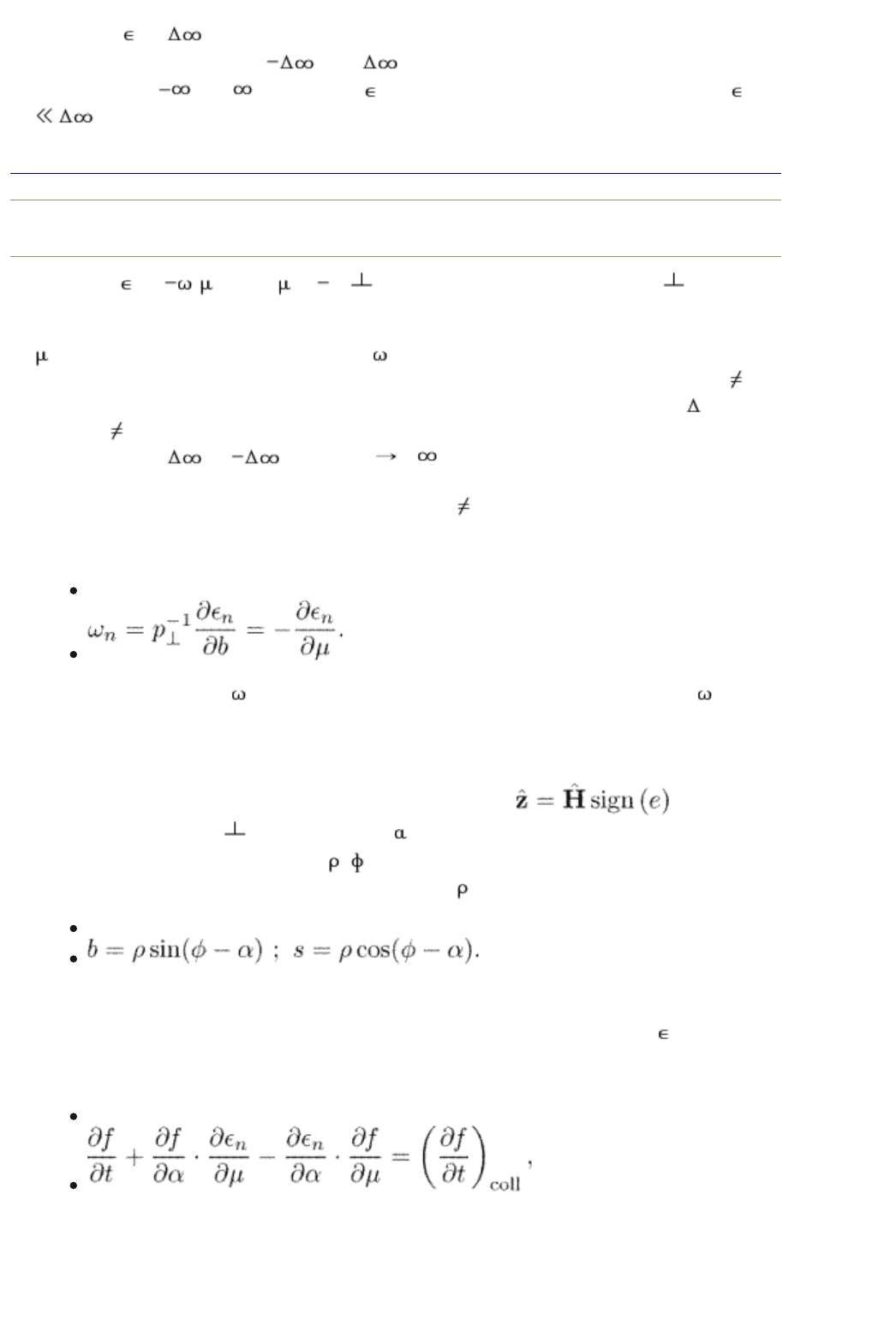
calculated in Section 6.4 (see Fig. 6.2). The localized states correspond to
energies |
| < . The spectrum has the so-called anomalous branch with n = 0
whose energy varies from
to + as the particle impact parameter b
changes from
to + and crosses = 0, being an odd function of b. For low
, the anomalous
end p.272
branch is
0
=
0
where = bp is the angular momentum, and p is the
momentum in the plane perpendicular to the vortex axis (Caroli et al. 1964). In
an, s-wave superconductor with an, axisymmetric vortex, the angular momentum
is quantized and so is the spectrum,
0
being the distance between the
discrete levels in the vortex core. The spectrum may also have branches with n
0 which are separated from the one with n = 0 by energies of the order of . The
states n
0 do not cross zero of energy as functions of b; they approach the
same energy +
or for both b ± . Numerical calculations (Gygi and
Schlüter 1991) show that these states are practically absorbed by the continuous
spectrum. However we include the states with n
0 into consideration for
generality. We denote the separation between the levels with neighboring
angular momenta through
(14.1)
The interlevel spacing
n
(b) is an even function of b for n = 0; the spacing
n
decreases with increasing n.
We choose the direction of the z-axis in such a way that the vortex has a positive
circulation. The z-axis is thus parallel the magnetic field for positive charge of
carriers, and it is antiparaliel to it for negative charge:
. Since
the particle velocity v
makes an angle with the x-axis, the cylindrical
coordinates of the position point (
, ) are connected with the impact parameter
and the coordinate along the trajectory through
2
= b
2
+ s
2
where
(14.2)
The coordinates are shown in Fig. 6.1.
The first step is as follows. We assume that the quasiclassical spectrum
n
(b) of
a particle plays the role of its effective Hamiltonian. We can thus invoke the
Boltzmann equation in the canonical form
(14.3)
to describe the quasiparticle distribution (Stone 1996). We shall derive eqn
(14.3) from our set of generalized kinetic equations in the following chapter.
Second, we assume that the force acting on a vortex from the environment is
PRINTED FROM OXFORD SCHOLARSHIP ONLINE (www.oxfordscholarship.com)
© Copyright Oxford University Press, 2003-2010. All Rights Reserved
Oxford Scholarship Online: Theory of Nonequilibrium Supe... http://www.oxfordscholarship.com/oso/private/content/phy...
第3页 共6页 2010-8-8 16:06

exerted via excitations localized in the vortex core. According to this picture, the
force on a moving vortex can be written as the momentum transfer from the
localized excitations to the vortex
(14.4)
Here we make use of the Hamilton equation
(14.5)
The second equality follows from the fact that, in the coordinate frame of Fig.
6.1, the energy only depends on the particle impact parameter b. The
normalization
end p.273
in eqn (14.4) is chosen such that the sum over the two spin states outers as
(1/2)
s
. We derive eqn (14.4) microscopically in Section 14.5.
We shall later demonstrate that eqn (14.4) indeed gives the full force on a vortex
if the vortex density is small enough. The measure of the vortex density is set by
the ratio of the Larnior radius r
H
=
F
/
c
of particles in the magnetic field B =
0
n
L
to their mean free path, . Here
c
= eB/mc is the cyclotron frequency and
n
L
, is the density of vortex lines. When the magnetic field is small (and so is the
vortex density) such that r
H
, i.e., the excitations with energies
above the gap
are in equilibrium, with the heat bath. f
1
= 0. According to
eqn (14.4) they do not produce a force and thus do not influence considerably
the vortex motion.
For a moving vortex, the force from the environment is balanced by the Lorentz
force:
(14.6)
with the flux quantum
0
= c/|e|. This form of the Lorentz force is the same as
in eqn (12.1) but the vortex circulation axis
is used. The force balance
equation
(14.7)
determines the transport current in terms of the vortex velocity and thus allows
to find the flux flow conductivity tensor.
14.1.2 Forces in s-wave superconductors
We consider a parabolic spectrum of quasiparticles in the normal state and thus a
spherical Fermi surface. We shall simplify the collision, integral in eqn (14.3)
PRINTED FROM OXFORD SCHOLARSHIP ONLINE (www.oxfordscholarship.com)
© Copyright Oxford University Press, 2003-2010. All Rights Reserved
Oxford Scholarship Online: Theory of Nonequilibrium Supe... http://www.oxfordscholarship.com/oso/private/content/phy...
第4页 共6页 2010-8-8 16:06
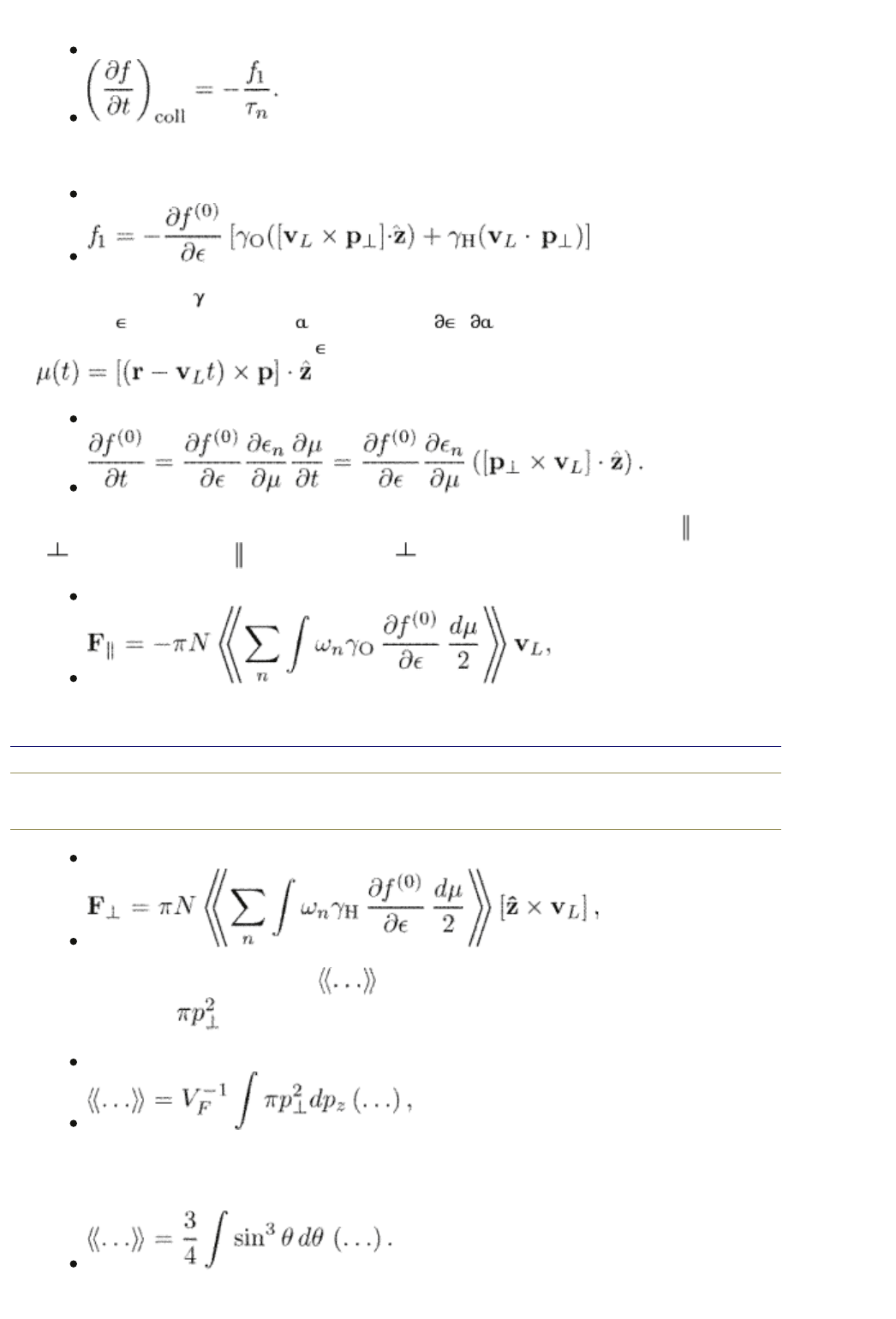
using the relaxation-time approximation
(14.8)
Equation (14.3) is easy to solve. Let us take the distribution function in the form
(14.9)
where the factors
O,H
are to be found. For an axi-symmetric s-wave vortex the
energies
n
do not depend on and the term
n
/ vanishes. In the term with
the time-derivative, the energy
n
contains a time dependence through
such that
(14.10)
With the Ansatz (14.9), the force eqn (14.4) splits into two terms F
env
= F +
F
, with the friction F and transverse F forces given by
(14.11)
end p.274
(14.12)
where N is the electron density, is the average over the Fermi surface
with the weight
,
(14.13)
and V
F
is the volume encompassed by the Fermi surface. For an isotropic Fermi
surface,
PRINTED FROM OXFORD SCHOLARSHIP ONLINE (www.oxfordscholarship.com)
© Copyright Oxford University Press, 2003-2010. All Rights Reserved
Oxford Scholarship Online: Theory of Nonequilibrium Supe... http://www.oxfordscholarship.com/oso/private/content/phy...
第5页 共6页 2010-8-8 16:06
